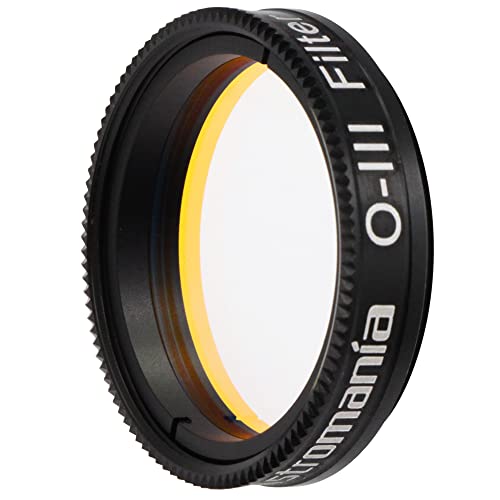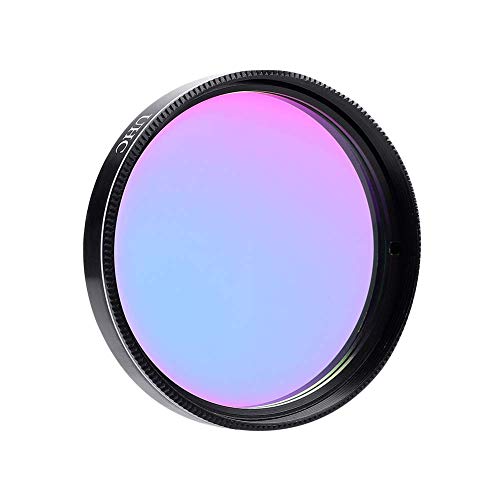Introduction
Light pollution while watching the night sky is such an annoyance and honestly, we get it. This is the reason lots of astronomers cannot watch the nebulae as they live in the cities.
And buildings, monuments, floodlights are the reasons for light pollution in the first place.
Then what can they do to pursue their hobby? Well, for starters they can buy a good filter that’s suitable for their telescope. But it’s so hard choosing one. What to do then?
Well, worry not! We got the solution for you. We’ve reviewed the best filter for galaxies along with different kinds of filters for different purposes.
So, you need to pick the filter that fits most of your criterias. Read the article to know which filters we’re suggesting for galaxies-
Comparison Table
| Products | Buying Features | Size |
| Great to look through light pollution | 1.25” | |
| SVBONY 1.25-Inch Telescope Filter | Improves image contrast | 1.25” |
| Solomark 1.25 Inch UHC Light Pollution Filter | Reduces light pollution | 1.25” |
| Astromania 1.25″ O-III Filter | Delivers great photographic views of The Veil, Dumbbell, the ring and Orion Nebula | 1.25” |
| Gosky 1.25″ UHC Ultra High Contrast Filter | Increases contrast | 1.25” |
SVBONY 1.25-Inch Telescope Filter
Product Overview
In our opinion, this is the second-best telescope filter. The first one helps you see through the light pollution, but this one enhances image contrast and thus reduces the effects of light pollution.
Let’s get to know more about this telescope-
If you’re not sure whether or not a light pollution filter will help you, it most likely will assist you. And this “SVBONY UHC Filter” is a cheap method to find out.
Best of all, once you have one, you won’t feel compelled to get a more expensive one. Because this one will most likely suit all of your requirements.
The “SVBONY ultra-high contrast filter/UHC telescope filter” increases the image contrast of nebulae and other astronomical figures.
This has light pollution reduction filters, also known as UHC filters. Here, the filter is meant to control the transmission of wavelengths of light. These particular wavelengths are produced by artificial light.
This filter is one of the most prominent astronomy equipment because of its capacity to generate extraordinarily sharp and clear images. Use this filter for celestial observations and astronomical photographies as well.
Also, the threads are well-made and thread into each eyepiece nicely. And you’ll find it effortless to insert in the case without contacting the glass, even in the dark.
This type of foam packing successfully preserves the product’s integrity during transit, and it also includes a shell for convenient storage. So, it is resistant to damage and dust.
The sky is significantly darker than it would be if you don’t use this. It does, however, produce a halo. If you lower the exposure, it disappears or lessens to the point where you won’t notice it.
Even when gazing through it without a telescope, the difference is noticeable. It works excellent and boosts the contrast, allowing me to view more of the night sky from where I live.
If there is no difference in light, it’s possible that this is due to overlapping spectrum conflicts between the light source and the light filter. You can alter the environment to see whether anything has changed, it’s better on 8-inch telescopes.
Pros.
- Great filter to use to see the nebula from light polluted skies.
- Nebulae are noticeably improved.
- Use the filter for astrogrpahy as well as observation of celestial objects
- The lens is made of optical glass, and the frame is made of aluminum.
- Significantly decreases light pollution; ideal for observation in cities and suburbs
Cons
- The eyepiece might be too small for your eyes.
- The rubber with the eyepiece isn’t of good quality.
Solomark 1.25 Inch UHC Light Pollution Reduction Filter
Product Overview
Yet another filter for watching the stars through the pollution. Don’t like to get disappointed by cheap filter not being able to deliver quality visions?
Yes, we get you. Let’s get into it, you’ll understand why it’s top-rated by us.
Make your darks deeper and your blacks blacker to provide new enlightenment to the night sky. This filter should be included in any well-stocked filter collection.
It even allows one to find both wonder and magnificence in the darkness, despite the night’s paradox and the light’s logic.
Are you living in a place of light pollution? Then this filter is fantastic for you. On clear evenings, you’ll be able to still see a faint glimmer from the Milky Way. It increases contrast a lot more than you’d expect.
Also, are you trying to see nebulas but failing with your filter? This makes the sky darkens dramatically, and the nebulas brighten dramatically.
The nebulas look considerably larger with this filter, with the dark streak splitting it standing out much more. You can easily spot triffid with this filter.
Besides this, the eyepiece is 1.25 Inch format. You can simply attach this eyepiece to your telescope. It’s packed in a durable clear case.
Not only night sky, but you can also use this for non-astronomical experiments as well. Either way, you’ll get a satisfying result for the price.
Pros
- The sky will be blackened in the background
- Simply attach to the eyepiece.
- Enhances contrast in any setting.
- It’s ideal for observing cities and suburbs.
- Limits light pollution considerably.
Cons
- The filter doesn’t have an anti-reflection layer on either side
- It doesn’t cut down the glare that much
Astromania 1.25″ O-III Filter
Product Overview
Tired of wanting to watch the night sky but no luck because of the light pollution? Happens. Let us introduce an amazing filter to you, with this you can watch the Veil, Ring, Dumbbell, and Orion Nebula.
Let’s talk about the features of the filter. In terms of function, the Astromania 1.25″ O-III Filter is similar to the Astromania UHC filter.
The difference is that only light from doubly ionized oxygen passes through this filter. This means that if the contrast in diffuse, planetary and nebulae is dim it’ll be greatly augmented.
This is a unique narrowband filter that allows for a lower wavelength range than the Astromania UHC filter. Apart from that, you can see a lot more astronomical figures with this filter that you cannot without this.
The Veil Nebula in the constellation of Cygnus is an excellent example. Due to its capacity to block any light outside of its 4960-5010 angstrom range, it’s an excellent tool for observing nebulae.
This filter is also suitable for astrophotography. Because the O-III 1.25″ Filter has a standard barrel diameter, it can be used with any brand of telescope.
It’s worth noting that the observed items have a green tinge while using this filter. On some objects, the O-III delivers a larger contrast enhancement than the UltraBlock narrowband filter.
And for nebulas, every little bit helps! It significantly enhances contrast and outperforms the UHC filter for most planetary nebulae, and it outperforms the UHC filter for all types of nebulae with apertures of 10″ or higher.
Only the two doubly ionized oxygen lines (496 and 501nm) produced by diffuse, cosmic, and extremely dim nebulae are isolated by the Astromania 1.25″ O-III Filter.
Pros
- The O-III Filter improves contrast when you’re viewing gaseous and planetary nebulae.
- This is especially useful for large aperture telescopes, where the Moon’s light can be highly overwhelming.
- Blocks practically all other visible wavelengths of light, allowing for better views of nebulas.
- Anti-reflection coating to avoid glaring and ghosting.
- Not only is it effective at light-polluted sites, but it also improves contrast at dark sky sites.
Cons
- It might make everything seem green for you.
- You might see a halo around the nebulas through it if you photograph through the filter.
Gosky 1.25″ UHC Ultra High Contrast Filter
Product Overview
This is the last telescope filter we’re reviewing. You’re going to love this telescope if you want a UHC filter. This filter increases contrast like no other filter.
UHC Filters are meant to restrict the transmission of certain wavelengths of light, particularly those generated by fluorescent lighting, selectively. The new ultra-high contrast UHC filter outperforms traditional broadband filters in terms of contrast.
The sky background will darken, and the contrast of emission nebulae will enhance substantially. You can view the nebula from light-polluted skies with the telescope. It can also enhance the contrast of the darkened sky.
The UHC filter offers key elements that set it apart and result in the greatest quality celestial views, in addition to its optimal spectral and optical characteristics. You can have an amazing view of the Orion, Lagoon, Swan using this filter.
The filter thread is suitable for 1.25” eyepieces. The frame is made of good metal and it has optical glass for easy watching.
Pros
- Enhances contrast in any setting.
- Cuts light pollution drastically.
- Filter thread for 1.25″ eyepieces and other accessories with a standard thread.
- Optical glassware with a metal structure
- The Orion, Lagoon, Swan, and other extended nebulae are all visible.
Cons
- High light pollution may not cooperate with the filter.
Buying Guide
The telescope filters we reviewed, all are amazing. But the features vary from filter to filter. And thus the cause of usage varies as well. So, do you know what you’re looking for in a filter? Let us help you.
Light Pollution
Do you live in a city? If so, the light pollution is supposedly higher than in other places. Then buy a filter that helps you look through the pollution.
Priority
There is a telescope filter made only to see the nebulae. If you’re putting priority into that, make sure the filter doesn’t create a halo around the nebulas.
Contrast
It doesn’t matter whether it’s nighttime watching or daytime watching. If you’re looking at the moon, the flare should be cut down and the contrast should be increased to look clearly.
FAQs
Question: Will a UHC filter be better for a galaxy?
Answer: Yes! A UHC filter will be way better for a galaxy. Here, the Ultra High Contrast Filters work at reducing the pollution in the air. As a result, you can observe the galaxies quite well enough.
Question: What color filters are best to view planets?
Answer: Yellow and Red color filters are the best in order to view the planets.
Verdict
Looks like we’ve come to the ending of this review article. So, buy the best filter for galaxies from the choices above.
Do comment below and share your experience with us. While buying, also make sure your filter’s features are compatible with your priorities. Take care!
SVBONY Telescope Filter 1.25 inches UHC Filter Astrophotography to Improve The Image Contrast Reduces Light Pollution (1.25 inch)
Solomark 1.25 Inch UHC Light Pollution Reduction Filter for Telescope
Astromania 1.25" O-III Filter - Produces Near-Photographic Views of The Veil, Ring, Dumbbell and Orion Nebula, Among Many Other Objects
UHC Filter 2 Inch Ultra High Contrast UHC Filter, Light Pollution Reduction Filter for Telescope Eyepiece
$26.55






